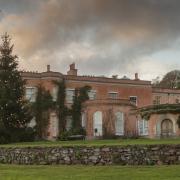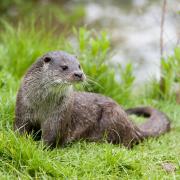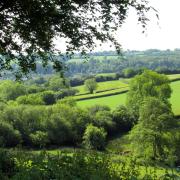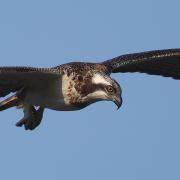Pullquote: 'It’s wonderful to see the little things coming out into the wild and starting a new life'
With whiskers glinting in the sunlight and bright eyes full of wonder, the pair slowly edge out of their straw-filled cage and – plop, plop – into the River Gara.
That distinctive sound is music to the ears of the team of volunteers here today who have been working for two years on a mission to bring water voles back to the south Devon countryside.
Members of the Habitat Group in the South Hams have been working with experts and landowners on a scheme to release up to 800 locally bred water voles into the wild.
Once commonplace around the rivers and streams of the UK, these impossibly cute little creatures have suffered an alarming drop in numbers over the past century, from eight million to about 132,000. By 2020 they were classed as ‘functionally extinct’ in Devon and Cornwall.
A combination of habitat loss, pollution and predation by the feral American mink are thought to be the three big reasons behind the sharp decline.
It’s no wonder then that the sound of water voles plopping into a stream have caused more than a ripple of excitement here this afternoon.

‘It’s wonderful to see the little things coming out into the wild and starting a new life,’ says John Nightingale, coordinator of the Habitat Group. ‘You hear the old boys in this area talking about the ‘plop’ sound they used to hear years ago. It would be great to think we’ll be hearing it again.’
Getting to this stage – the release of the first batch of 200 water voles into the River Gara - has been a champion collective effort.
Detailed surveys of the area have been carried out by Devon-based water vole expert and ecologist Derek Gow and his team to check the habitat is suitable and that there are no minks about.
Local communities have teamed up to provide boots on the ground for the practical work needed, as well as raising funds for the long-term project that will eventually see up to 600 more water voles introduced to the River Gara and its tributaries over the next two years.
‘It’s an exciting day for us,’ says Sue Hadow, also a member of the Habitat Group. She and husband John run the farm near Blackawton where the first of the water voles are being released this afternoon. ‘We’ve been here for 25 years and we haven’t seen any around,’ she says, explaining why she decided to get involved with water voles. ‘We started thinking – why aren’t there any here and what can we do about it?’
Sue, busy handing out tea, water and homemade courgette cake to the volunteers who have gathered in her garden, adds it’s been a steep learning curve. She and John have taken part in a water vole course to learn more about the species and the logistics of the release programme.
Most of the three to four-month-old water voles here today are being placed in specially prepared cages by the river and ponds on the farmland. They will be checked on and fed for five days by Sue and other volunteers before the cage doors are opened.
The other, slightly older (and wiser, hopefully) animals are being plopped straight into the water, ready to make their big comeback.
It’s a lot of pressure on their furry shoulders but these little mammals lined up here today should be up to the task.
‘I’m just looking them over and giving them a quick health check,’ says ecologist and water vole expert Jenny Tratt, here today to make such every animal is ready to ‘rock and vole’ (sorry).
‘Their teeth should be nice and orange,’ Jenny continues. ‘If they have pale teeth, it means they’re not well. I’m also checking their eyes – this one is looking fine.’
Jenny, who works for Derek Gow, is using a highly sophisticated piece of equipment to do her checks. ‘It’s a Pringles tube!’ she says (sour cream and onion flavour, in case you were wondering). ‘It works really well.’

Jenny carefully and skilfully uses the empty cardboard tube to encase each water vole before gently coaxing out the tail, which she grabs. The wriggly rodent is then placed on top of the tube, ready to be given a once over before being popped into a waiting cage full of bedding and a few bits of chopped up carrot and apple.
‘Right, this one’s a bit feisty, let’s get him in quickly,’ says Jenny, who has handled a few voles in her time and knows when to let go. ‘Some of them go down immediately and some put up a bit of a fight.’ Pen number 13 – we’re looking at you two.
Once everyone has settled in, it’s time for these ‘soft releases’ to be taken to their chosen spot.
This involves carefully carrying the sizeable cage and its inhabitants across some tricky terrain through fields and across ditches. I’ve volunteered my son Jake, 15, to help out today and he dutifully sets off downhill, determined to do his bit for local biodiversity.
‘That’s really what we’re driving at,’ says fellow volunteer Victoria Benns. She founded Wild About Nature to help people reconnect with their landscape. ‘I think that’s what’s so nice about what we’re seeing here today,’ she adds. ‘It’s about getting the local community interested in the wildlife on their doorstep, what’s right here around us.
‘We’ve got to get the community involved, otherwise, what’s the point?’
She’s right, of course. Climate change and protecting our planet starts at home, one water vole at a time. And I can guarantee that the 10 or so people who have turned out here today (including Jake and I) to see these important little animals back where they belong won’t ever forget it.
‘Look at how fast they go!’ says Jake, fresh from setting free two ‘hard releases’ into a beautiful big pond, right next to a stream. ‘Good luck out there…’.
To find out more, see the habitatgroup.uk



























